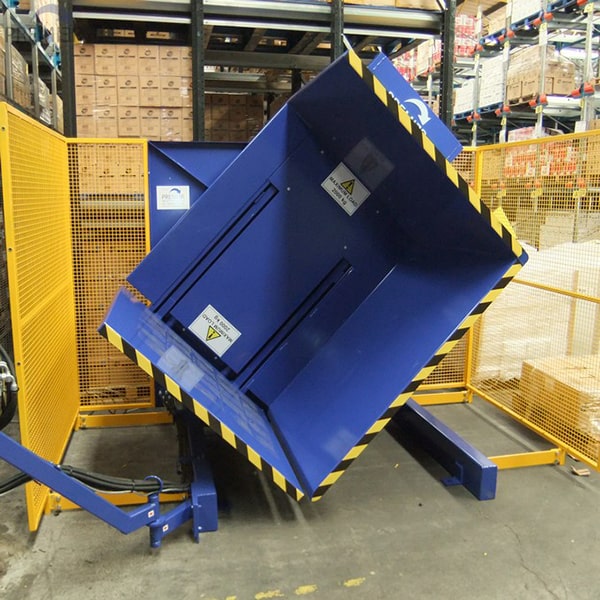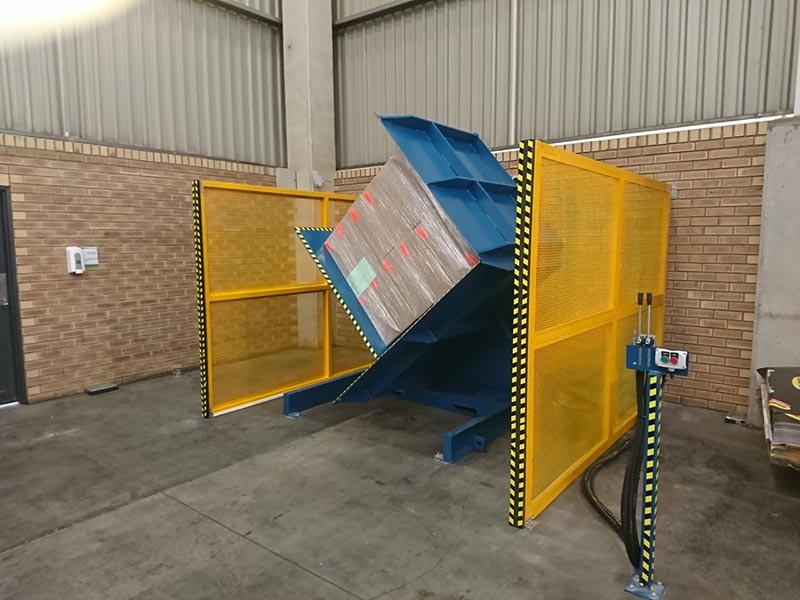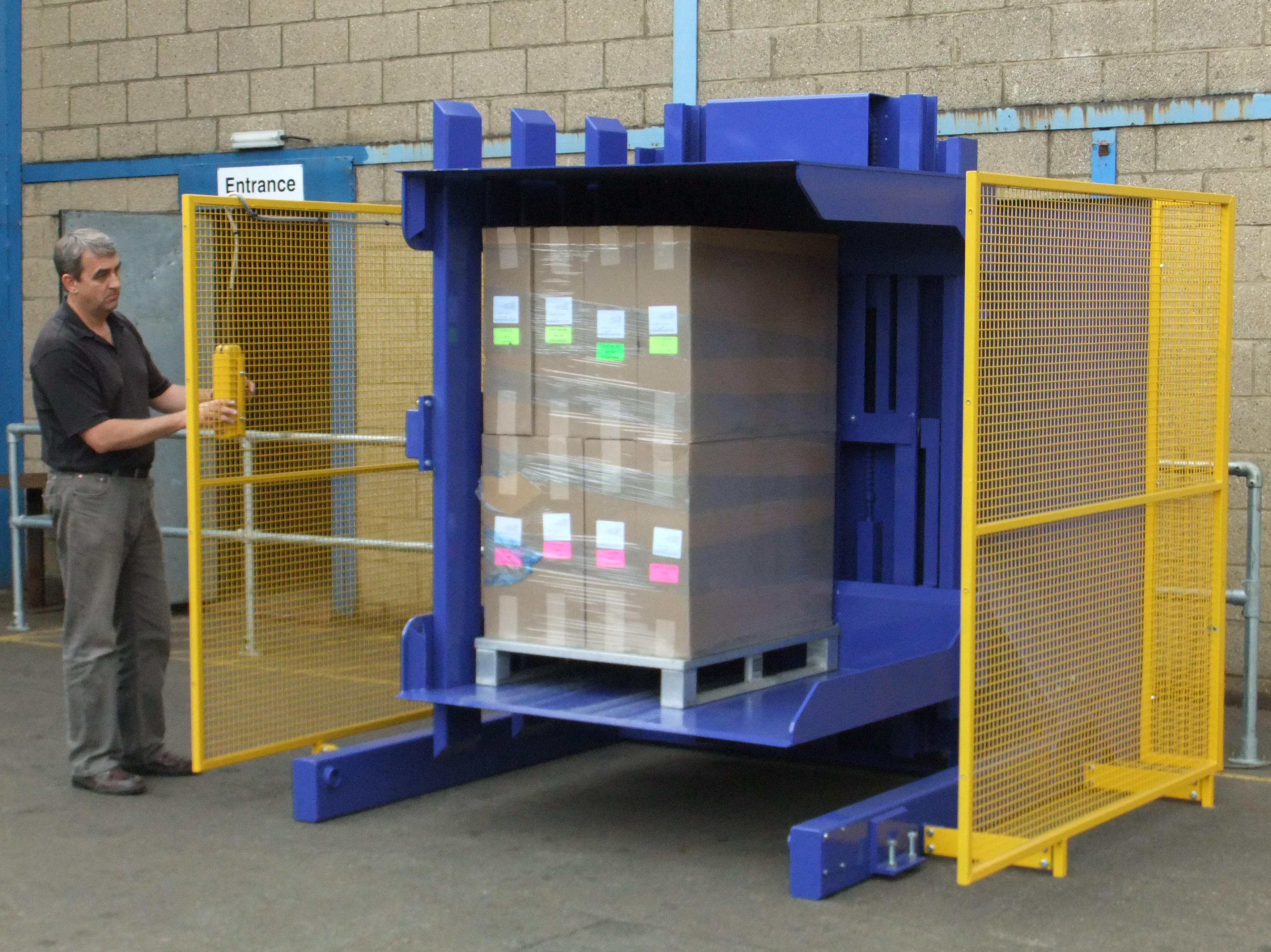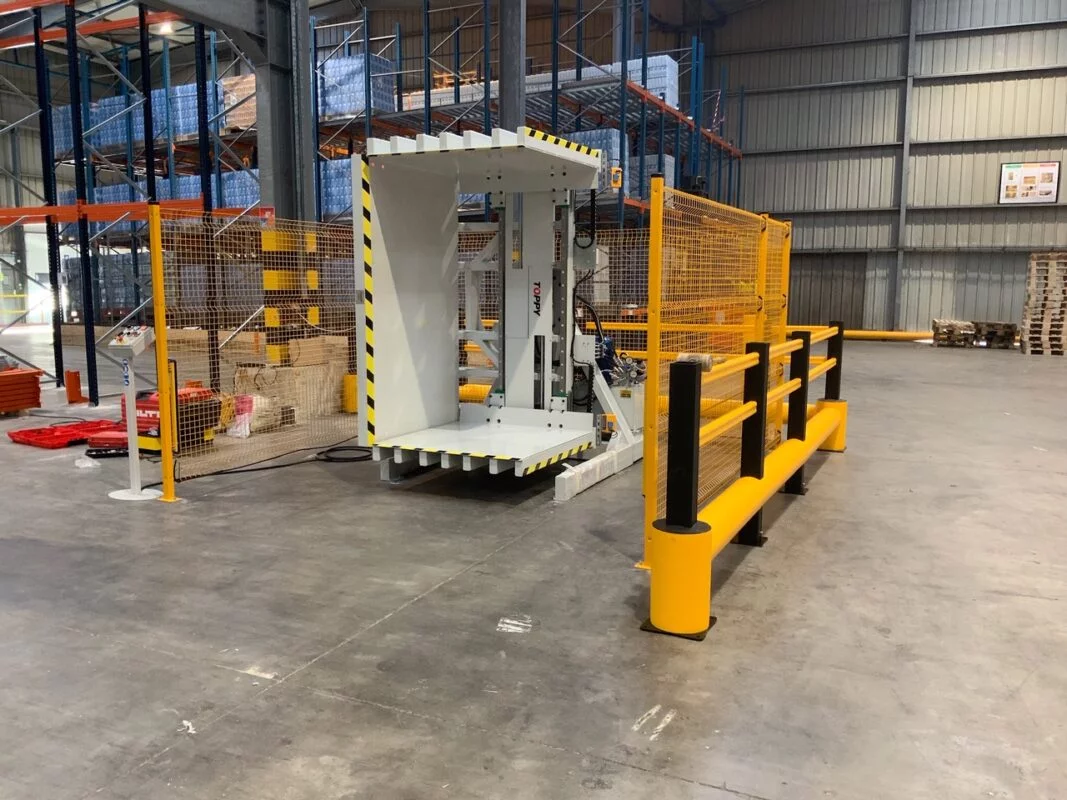Choosing the Right Pallet Inverter for Saudi Arabia's Demands in Heat-Resistant Equipment for Food & Beverage
As an engineer who has spent his entire career in the packaging machine industry, I've seen firsthand how the right equipment can make or break an operation. You might have a state-of-the-art production line, but if your end-of-line handling equipment can't keep up or fails under pressure, the entire system grinds to a halt. This is especially true in demanding environments like Saudi Arabia's food and beverage sector. You face intense heat, strict hygiene rules, and the constant pressure to maintain efficiency. Choosing a piece of equipment like a pallet inverter isn't just a small purchase; it's a critical investment in your plant's reliability and safety.
Choosing the right pallet inverter for Saudi Arabia's food and beverage industry means prioritizing models built with 304 or 316-grade stainless steel for hygiene and corrosion resistance. It must also feature high-temperature-rated hydraulic systems, sealed electronics with proper cooling, and compliance with food safety standards like HACCP to withstand the region's harsh climate and strict regulations.

I've learned that a machine's success isn't just about its specifications on paper. It’s about how it performs in the real world, day in and day out. The challenges in Saudi Arabia are unique. The heat isn't just a minor inconvenience; it's a constant force that can degrade machine components. The focus on food safety is absolute. In this guide, I want to share my practical insights, moving beyond the sales brochure to help you understand the critical details. We will break down exactly what you need to look for to ensure your pallet inverter is a long-term asset, not a short-term headache.
Why is Stainless Steel Construction a Must-Have for Food & Beverage Pallet Inverters in Saudi Arabia?
You run a busy food processing facility. You know you need to prevent contamination. You might think that any machine with a "clean" look will do the job. But then you start your rigorous cleaning schedule. The harsh sanitizing chemicals start to pit and corrode the painted surfaces of your standard pallet inverter. These tiny spots become breeding grounds for bacteria. An inspector notices this, and suddenly your operation is at risk. You realize that "looking clean" is not the same as being hygienically designed.
Stainless steel is a must-have for pallet inverters in Saudi Arabia's food & beverage sector because it prevents rust and corrosion from high humidity and frequent chemical wash-downs. Its non-porous, smooth surface is easy to clean and sanitize, preventing bacterial growth and ensuring you can meet strict food safety standards like HACCP and SFDA (Saudi Food and Drug Authority) regulations.

When I started my own factory, I had to learn about material science in a very practical way. It’s not just about choosing stainless steel; it’s about choosing the right kind of stainless steel and ensuring the entire machine is built with hygiene in mind. A machine is only as strong as its weakest link. A single poorly welded joint or a rough surface can compromise your entire food safety protocol. Let's look deeper into what this means for your equipment.
The Difference Between Stainless Steel Grades
Not all stainless steel is created equal. For most food applications, you will choose between two main grades: 304 and 316.
- Grade 304 Stainless Steel: This is the workhorse of the food industry. It offers excellent corrosion resistance to a wide variety of food products and cleaning solutions. For many applications, like handling dry goods, it is perfectly sufficient and more cost-effective.
- Grade 316 Stainless Steel: This grade contains an important addition: molybdenum. This element gives it superior resistance to chlorides, which are found in many sanitizing agents and in certain food products like brines. If your process involves high salt content or you use very aggressive, chloride-based cleaners, investing in Grade 316 is essential insurance against corrosion.
Surface Finish and Hygienic Design
The grade of the steel is just the start. The finish of that steel is equally important for cleanability. A rough surface, even on high-grade steel, can trap microscopic food particles. You should look for a smooth, polished, or bead-blasted finish that is free of cracks and crevices.
Furthermore, a truly hygienic design considers the entire structure.
- Continuous Welds: Look for machines with continuous, smooth welds instead of "stitch" or "tack" welds. Continuous welds eliminate gaps and seams where moisture and bacteria can collect.
- Avoiding Hollow Sections: Hollow, unsealed tubes or frames are a major red flag. They can trap water from wash-downs, leading to hidden bacterial growth and corrosion from the inside out. All structural components should be solid or fully sealed.
- Sloping Surfaces: Well-designed equipment often incorporates slightly sloped surfaces to ensure water drains off completely after cleaning, rather than pooling.
Here is a simple breakdown to help you decide:
| Feature | Grade 304 Stainless Steel | Grade 316 Stainless Steel |
|---|---|---|
| Key Alloy | Chromium, Nickel | Chromium, Nickel, Molybdenum |
| Corrosion Resistance | Good for general use, most foods | Excellent, especially against chlorides/salts |
| Cost | Lower | Higher (approx. 20-30% more) |
| Best For | Bakeries, dry goods, general processing | Meat/poultry brines, salty snacks, harsh chemical sanitation |
How Do High Ambient Temperatures in Saudi Arabia Affect a Pallet Inverter's Performance and Design?
Imagine this scenario. It's the middle of the afternoon in Riyadh. The temperature inside your non-air-conditioned warehouse is soaring above 45°C (113°F). You have a rush order to get out, but your pallet inverter is moving slowly, and its motor sounds strained. A few cycles later, it stops completely. Your maintenance team finds that the hydraulic oil has become thin and watery from the heat, causing the pump to overheat and fail. Now your entire shipping process is stalled, all because the machine wasn't built to handle the local climate.
High ambient temperatures in Saudi Arabia directly impact a pallet inverter by causing hydraulic oil to thin and overheat, which can damage seals, pumps, and valves. These temperatures can also lead to the premature failure of critical electronic components like PLCs, VFDs, and sensors if they are not housed in properly ventilated or cooled enclosures and rated for high-temperature operation.

In my early days as an engineer, I saw clients buy European machines that were excellent in the mild climates they were designed for. But when they were deployed to hotter regions, they started having mysterious problems. This taught me that the operating environment is just as important as the machine's function. A machine is a system of parts, and heat is an enemy to almost every part of that system, from its hydraulic fluid to its electronic brain. Let's break down the specific areas you need to inspect.
Protecting the Hydraulic Heart
The hydraulic system is the muscle of most pallet inverters. Heat is its biggest threat.
- Hydraulic Oil: Standard hydraulic oil loses viscosity (thins out) as it gets hotter. This reduces lubrication and can cause premature wear on the pump and other components. You must insist on using high-viscosity index (HVI) hydraulic oil, which maintains its thickness better across a wider range of temperatures.
- Reservoir Size: A larger hydraulic reservoir allows the oil more volume and surface area to cool down naturally. A machine with a tiny, compact reservoir is more likely to overheat in a hot environment.
- Oil Coolers: For heavy-duty or continuous use in extreme heat, an oil cooler is not a luxury; it's a necessity. These devices, which can be either air-cooled or water-cooled, actively remove heat from the hydraulic fluid, keeping the system at a stable operating temperature and dramatically extending its life.
Keeping the Electronics Cool
The electronic control cabinet is the brain of the machine. Just like a human brain, it doesn't function well when it's too hot.
- Component Temperature Ratings: Every electronic part, from the PLC to the power supply, has a maximum operating temperature. Standard components might be rated for 40°C. In Saudi Arabia, you need components rated for at least 50°C or higher.
- Enclosure and Cooling: The control panel must be properly sealed to keep out the fine dust common in the region. A NEMA 4X or IP66 rated enclosure is a good standard. But a sealed box also traps heat. Therefore, it must have a reliable cooling solution. This could be as simple as ventilation fans with filters for less extreme areas, or a panel air conditioner for mission-critical machines in the hottest locations.
Here’s a quick reference for heat-related issues and their solutions:
| Problem | Symptom | Design Solution |
|---|---|---|
| Hydraulic Overheating | Sluggish operation, whining pump | Use HVI oil, large reservoir, add an oil cooler |
| Electronic Failure | Glitching controls, blank screen | Use high-temp rated components, ventilated or A/C cabinet |
| Premature Seal Wear | Hydraulic fluid leaks | Proper oil and cooling to prevent oil breakdown |
| Motor Overload | Motor tripping its breaker | Ensure motor is properly sized and has adequate ventilation |
What Safety and Compliance Standards Should You Prioritize for Pallet Inverters in the Saudi Food Sector?
You've found a pallet inverter that's made from the right steel and has a robust cooling system. It seems perfect. You import it and put it into service. However, during an inspection by the Saudi Civil Defense or a third-party safety auditor, they flag the machine. It's missing required light curtains and has exposed pinch points. Your operation is halted until you can make expensive, custom modifications. Worse yet, an operator, trying to work quickly, gets their hand caught because the emergency stop was poorly placed. The cost of non-compliance is never just financial.
When selecting a pallet inverter for the Saudi food sector, you must prioritize CE marking for machinery safety, SASO conformity for local market access, and HACCP-compliant design for food safety. Functionally, this means demanding features like safety light curtains, dual-channel emergency stop circuits, and physical guarding around all moving parts to protect operators and meet regulations.

I have seen the evolution of machine safety over my career. What was once considered optional is now the absolute standard. For me, safety is not about just meeting a regulation; it's about respecting the people who operate the machines every day. A safe machine is an efficient machine because operators can work confidently without fear of injury. In a market as stringent as Saudi Arabia, proving your commitment to safety through certified equipment is essential for your reputation and your license to operate.
Understanding Key Certifications
Certifications are a manufacturer's promise that a machine meets a certain standard. Here are the ones you should look for:
- CE Marking: While a European standard, the CE mark is globally recognized as a benchmark for machinery safety. It indicates that the manufacturer has assessed and declared the machine compliant with health, safety, and environmental protection standards.
- SASO Certificate of Conformity (CoC): This is a mandatory requirement for many products imported into Saudi Arabia. It is issued by an approved body and certifies that your machine complies with Saudi national standards. Ensure your supplier can provide this.
- HACCP (Hazard Analysis and Critical Control Points): This is not a machine certification, but a system for managing food safety. The machine's design must support your HACCP plan. This refers back to the hygienic design principles we discussed, such as using stainless steel, ensuring easy cleanability, and using food-grade materials where necessary.
Essential Operator Safety Features
Beyond certifications, you must look for tangible safety features on the machine itself.
- Safety Light Curtains: These create an invisible infrared barrier around the hazardous areas of the machine. If an operator's hand or body breaks the beam while the machine is in motion, it immediately stops, preventing crushing or pinching injuries.
- Physical Guarding: Fencing or physical barriers are the simplest and most effective way to keep people away from moving parts. These guards should have interlocked gates, meaning the machine will stop if a gate is opened.
- Emergency Stops (E-Stops): These must be prominent, easy to reach from all operator positions, and wired in a dual-channel, fail-safe manner. Pushing the button should immediately and safely halt all machine motion.
- Two-Hand Controls: For some operations, requiring the operator to press two buttons simultaneously ensures their hands are away from the moving parts of the machine during a cycle.
This table connects the features to their purpose:
| Safety Feature | Purpose | Why It's Critical in the Food Sector |
|---|---|---|
| Safety Light Curtains | Creates a non-contact safety zone | Allows for quick pallet loading/unloading while ensuring operator safety |
| Stainless Steel Guarding | Provides a physical barrier | Prevents accidental contact; must be easy to clean |
| Interlocked Gates | Stops machine when guard door is opened | Ensures no one can enter the operating zone during a cycle |
| Clearly Marked E-Stops | Immediate machine shutdown in an emergency | Crucial in a fast-paced environment to prevent serious injury |
Beyond the Machine: What Level of Supplier Support is Crucial for Operating in Saudi Arabia?
You've done all your homework. You've ordered a top-of-the-line, heat-resistant, stainless steel pallet inverter with all the right safety features. It arrives from a factory halfway across the world. But the installation instructions are unclear, and you have to rely on local contractors who have never seen this machine before. Six months later, a unique sensor fails. The overseas supplier is helpful on the phone, but it will take three weeks to ship the replacement part. Your entire production line, which depends on this one machine, is now idle. The "great price" you got on the machine is now costing you thousands of dollars a day in lost production.
Crucial supplier support for a pallet inverter in Saudi Arabia extends beyond the sale to include professional installation and commissioning by trained technicians, a local or regional inventory of critical spare parts to minimize downtime, and comprehensive, hands-on training for your operators and maintenance staff.

This is perhaps the most important lesson I have learned, both as a buyer and now as a manufacturer. A machine is only as reliable as the support system behind it. When I founded SHJLPACK, my goal was to offer a "TOTAL SOLUTION," not just a wrapping machine. That means being a partner, not just a vendor. A client's success is my success. This is especially true when operating in a specific region like Saudi Arabia, where logistics and local expertise are everything. Your supplier shouldn't disappear after they've been paid.
My Insight: The True Value of Partnership
I remember a client in the steel industry, a man very much like Javier Morales, who ran a large mill. He bought a very complex, expensive piece of equipment from a well-known European brand. It was a marvel of engineering. But when a small, 50-euro proprietary sensor failed, his entire line stopped. The manufacturer was responsive, but the part had to ship from Germany. It took two weeks. Two weeks of downtime for a 50-euro part.
That experience taught me that the initial price of a machine is only one part of its total cost of ownership. Downtime is the real expense. This is why when you evaluate a supplier, you must ask tough questions about their support infrastructure in your region.
- Do they have local or regional technicians?
- Do they have a partner in Saudi Arabia or the GCC?
- Do they maintain a stock of critical spare parts locally?
- What is their guaranteed response time for a service call?
What to Demand from Your Supplier
A strategic partner will offer a complete support package.
- Installation and Commissioning: They should offer to send their own qualified engineer or have a certified local partner to manage the installation. This ensures the machine is set up correctly, calibrated, and all safety features are tested and functional from day one.
- Spare Parts: A professional supplier will provide you with a recommended list of critical spare parts to keep on-site. For more expensive or less common parts, they should have a regional depot to reduce shipping times from weeks to days.
- Training and Documentation: The supplier must provide clear, detailed manuals in English (and preferably Arabic). More importantly, they should offer hands-on training for two groups: your operators (on safe and efficient use) and your maintenance team (on routine servicing, troubleshooting, and basic repairs). An empowered team is your first line of defense against downtime.
Think of your supplier relationship with this simple checklist:
| Support Element | Bad Supplier (Vendor) | Good Supplier (Partner) |
|---|---|---|
| Installation | "We ship to port. Installation is your problem." | "Our engineer will be on-site to oversee commissioning." |
| Spare Parts | "All parts ship from our main factory." | "We stock critical parts with our local partner." |
| Training | "The manual is on the USB drive." | "We will conduct on-site training for your operators & maintenance." |
| Troubleshooting | "Send us an email and we will reply." | "You have a direct line to our regional technical support." |
Conclusion
Choosing the right heat-resistant pallet inverter for Saudi Arabia is about more than specs. It’s about ensuring hygiene, reliability in extreme heat, operator safety, and strong local support.



